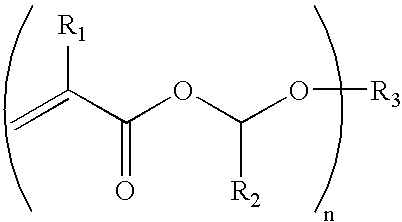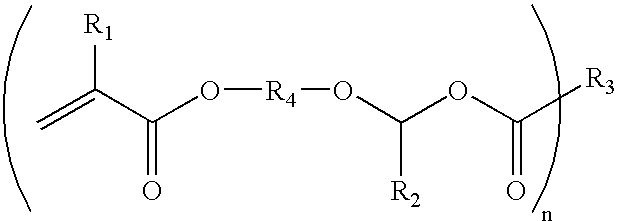Multi-functional alpha-alkoxyalkyl acrylate and methacrylate ester compositions and reworkable polymers formed therefrom
a technology of methacrylate and alkoxyalkyl acrylate, which is applied in the direction of adhesive types, other domestic articles, coatings, etc., can solve the problems of poor inability unsuitable, and difficult to decompose by heating
- Summary
- Abstract
- Description
- Claims
- Application Information
AI Technical Summary
Benefits of technology
Problems solved by technology
Method used
Image
Examples
example 1
Synthesis of Reactive Component Compound A: bis-1-(1′,6′-hexoxy)ethyl methacrylate
[0036] Compound A is an example of a multi-functional alpha-alkoxyalkyl methacrylate ester useful in compositions of the present invention.
[0037] 1,6-hexanediol divinyl ether (17.003 g; 0.1 moles) and 4-tert-butylcatechol (0.0071 g; 0.043 millimoles) were added to a 50 ml reaction flask fitted with a heating mantel, thermocouple and pressure compensating addition funnel, thermocouple, reflux condenser and magnetic stirrer. The mixture was stirred and methacrylic acid (17.204 g; 0.2 moles) was added dropwise over 45 minutes, while the temperature was Compound A 174° C. and 82° C. When the addition was complete, the mixture was heated at 80° C. for a further 5 hours and cooled to room temperature to afford the liquid monomer bis-1-(1′,6′-hexoxy)ethyl methacrylate (Compound A) in 98% yield (33.40 g). The structure was confirmed by 1H NMR and infrared spectral analysis.
example 2
Synthesis of Reactive Component Compound B: triethylene glycol bis-[1-(2-acryloxyethyl)ethyl ether]
[0038]
[0039] A mixture of 1 equivalent of triethylene glycol divinyl ether and 2 equivalents of beta-carboxyethyl acrylate are reacted together according to the procedure described in Example 1 to give triethylene glycol bis-[1-(2-acryloxyethyl)ethyl ether] (Compound B) in quantitative yield. In a composition of the present invention, Compound B is capable of curing through a free radical polymerization reaction to form a reworkable polymer.
example 3
Synthesis of Reactive Component Compound C: 1-n-butoxyethyl methacrylate
[0040]
[0041] The reaction procedure of Example 1 was repeated using unts of n-butylvinyl ether and methacrylic acid. The structure of the product, 1-n-butoxyethyl methacrylate (Compound C) was obtained in 88% yield. Compound C is an example of a mono-functional alpha-alkoxyalkyl(meth)acrylate which may optionally be included with multi-functional alpha-alkoxyalkyl(meth)acrylate compounds in compositions of the present invention. The structure of Compound C was confirmed by 1H NMR and infrared analysis.
PUM
| Property | Measurement | Unit |
|---|---|---|
| temperature | aaaaa | aaaaa |
| temperature | aaaaa | aaaaa |
| temperature | aaaaa | aaaaa |
Abstract
Description
Claims
Application Information
 Login to View More
Login to View More - R&D
- Intellectual Property
- Life Sciences
- Materials
- Tech Scout
- Unparalleled Data Quality
- Higher Quality Content
- 60% Fewer Hallucinations
Browse by: Latest US Patents, China's latest patents, Technical Efficacy Thesaurus, Application Domain, Technology Topic, Popular Technical Reports.
© 2025 PatSnap. All rights reserved.Legal|Privacy policy|Modern Slavery Act Transparency Statement|Sitemap|About US| Contact US: help@patsnap.com



